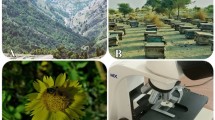Summary.
Honey bee (Apis mellifera) workers police each other's reproduction by eating worker-laid eggs while preferentially leaving queen-laid eggs. Policing effort is presumably associated with biological costs, including those of search time and of errors of identification of eggs so that the wrong eggs are retained or eaten. Selection should act to minimise these costs. One way costs can be reduced is to focus policing effort on eggs that are most likely to be worker laid. We show here, in accordance with this prediction, that policing effort is focussed on drone cells where workers are more likely to lay eggs, rather than on worker cells which are more likely to contain queen-laid eggs.
Similar content being viewed by others
Author information
Authors and Affiliations
Additional information
Received 14 March 2002; revised 15 August 2002; accepted 11 September 2002.
RID="*"
ID="*"Author for correspondence.
Rights and permissions
About this article
Cite this article
Halling, L., Oldroyd, B. Do policing honeybee (Apis mellifera) workers target eggs in drone comb?. Insectes soc. 50, 59–61 (2003). https://doi.org/10.1007/s000400300009
Issue Date:
DOI: https://doi.org/10.1007/s000400300009




